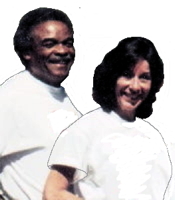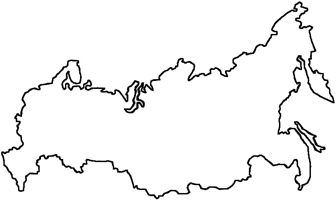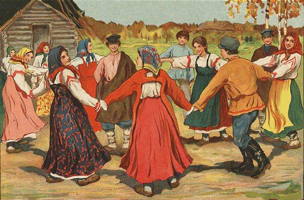
|
The Society of Folk Dance Historians (SFDH)
Russian Folk Dance
[
Home |
About |
Encyclopedia | CLICK AN IMAGE TO ENLARGE |

|
BACKGROUND
 Information: Each of the folk dances of the Russian people has definite content, infusing them with unique national flavor and enabling them to express a myriad of thoughts and feelings.
Information: Each of the folk dances of the Russian people has definite content, infusing them with unique national flavor and enabling them to express a myriad of thoughts and feelings.
The types of Russian dances may be divided into several categories, the most widespread of which are the Khorovods (choral dances), Quadrilles (danced by six, seven, or eight couples), and the Polkas. The Khorovod is a country dance game of singing and dancing played outdoors by the young men and women of the village during the spring and summer months.
KHOROVOD
 The dances of the Khorovod, both slow and fast, are built on very simple, restrained movements woven into a variety of patterns and figures. The simplicity of the steps, however, does not preclude competitive improvisation and rivalry among the dancers. Most dancing is started by a leader who is soon joined by others who compete with one another in displaying their skills. The best dancer is the one who can repeat the improvisations of his rivals yet make improvisations that his rivals cannot duplicate.
The dances of the Khorovod, both slow and fast, are built on very simple, restrained movements woven into a variety of patterns and figures. The simplicity of the steps, however, does not preclude competitive improvisation and rivalry among the dancers. Most dancing is started by a leader who is soon joined by others who compete with one another in displaying their skills. The best dancer is the one who can repeat the improvisations of his rivals yet make improvisations that his rivals cannot duplicate.
Following are descriptions of Khorovod dances found in the Kalinin region of Russia.
The slow-moving Khorovod begins with a group of young women and one of young men joining hands and advancing to meet one another. The women dance forward with eyes lowered. In the meantime, the men flirt with them. They then bow and form an arch with their arms under which the women pass. The women then form the same sort of arch for the men. Two circles are then formed, with the women on the inside. The women move to the right, the men to the left. The circles then repeatedly break up into spinning couples and then form again.
A second, somewhat faster Khorovod, starts with two circles that quickly break up into smaller "right-hand star" circles. The small stars scatter and then form one large star in which the women give their left hands to the men and join right hands with another woman's. The women whirl from one man to another, passing under arches formed by a man and a woman joining hands. Eventually, the big star falls to pieces and the couples dance back to their original places.
The fast moving Khorovod has as its main feature individual dances presented by each couple. Each couple takes the center of the circle in turn and does a dance of their own invention, called the Koleno.
QUADRILLES
Quadrilles are group dances favored by many villagers. The pattern in a figure and the manner in which the figures (straight lines, circles, zig-zags, spirals, and arches) are executed varies from region to region, if not from village to village. In one region, the quadrille steps are danced smoothly, with great restraint, giving the dance an aura of great dignity. The women hold out their hands with an air of "importance," and dance with their heads bent slightly toward the shoulder of their partners. In another region, the quadrille is filled with buoyancy, energy, and daring. A great deal of improvisation occurs, and includes some very fast tap dancing on the part of the women and squats with numerous variations on the part of the men.
The "posidyelka" is the most common type of social gathering. The word "posidyei" means "to sit a while." When a particular evening arrives, village women take their work to a cottage selected for the gathering, spend some time spinning and combing flax, hemp, and wool. As they work, there's a lot of laughter and chatter, lots of talk about domestic affairs and/or their boyfriends. Work and chatter last until suppertime and after supper they throw aside their work and take to playing games. A little later, the men appear in small groups, and greet the women, especially their regular sweethearts, whom they will most likely marry. Then dancing begins, to the sound of reed pipes, balalaikas, and other musical instruments, as well as songs sung by the women in chorus. Steps to the dances are simple and subordinate to the words of the songs. If the women form a circle around the men dancers, special dance-songs called "plyasovuiya pyesni" are sung.
"Besyedas" are gatherings held in a large "izba," a cottage specifically cleaned and prepared for the men of the village to use for their nightly meetings during the winter months. These gatherings usually start after supper and last until late in the evening. Each of the men pays the owner of the cottage each night for the right of entry. When music is desired, special collections are made for the purpose. As a general rule, women are admitted free for dancing. One description of a "besyeda" includes women dressed in colorful finery occupying benches stretching from the stove to the center window, old people and married couples sitting near the stove, and young men, primarily dressed in blue caftans, strolling around on the side of the room not occupied by the young women.
During the evening's entertainment at both kinds of gatherings, games and dances followed a particular order that was dictated by the customs of the village.
DOCUMENTS
- Russia, a country.
- Russian Dance and Music, an article.
Printed in Folk Dance Scene, March 1997.
This page © 2018 by Ron Houston.
Please do not copy any part of this page without including this copyright notice.
Please do not copy small portions out of context.
Please do not copy large portions without permission from Ron Houston.